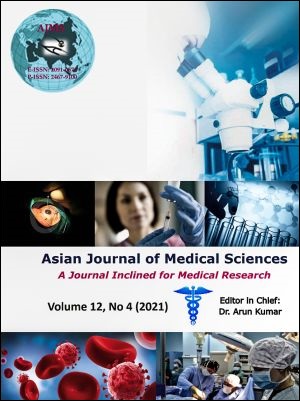Seroprevalence and clinical profile of scrub typhus in patients presenting with undifferentiated acute febrile illness in a tertiary care centre
Keywords:
Cut-off, Enzyme Linked Immunosorbent Assay, Fever, Rash, Weil Felix TestAbstract
Background: Scrub typhus (ST) is a common Rickettsial infection which has been increasingly reported from the various states of southern part of India.
Aims and Objective: With very few reports from Central Kerala, we aimed to study the seroprevalence of scrub typhus and its clinical profile.
Materials and Methods: Patients presenting with acute undifferentiated febrile illness and other symptoms and signs of Rickettsial infections during a period of two years were included in this prospective study. Serodiagnosis of ST was based on a positive Scrub typhus IgM Enzyme Linked Immunosorbent Assay (ELISA) and/or agglutination for OXK in Weil Felix test. The cut-off for ELISA was calculated. The clinical and laboratory details of the positive patients were obtained and bivariate analysis was performed.
Results: The cut-off for ST IgM ELISA was calculated and found to be 0.38. Of the 636 samples screened, 34 (5.3%) were positive for ST IgM ELISA. Out of the 34 positive samples, only 5 (0.8%) were positive by Weil Felix test. Most of the ST patients presented during the months of May to January. Rashes were observed in 8.8% of the ST patients and none had signs of eschar. The commonest clinical features included fever, myalgia (52.9%), nausea & vomiting (32.4%), headache (29.4%) and hepatosplenomegaly (29.4%). The commonest abnormal laboratory finding and complication observed were elevated serum transaminases (52.9%) and acute respiratory distress syndrome (17.6%) respectively.
Conclusion: The seroprevalence of ST in Central Kerala was 5.3% using Weil Felix test and ST IgM ELISA.
Downloads
Downloads
Published
How to Cite
Issue
Section
License
Authors who publish with this journal agree to the following terms:
- The journal holds copyright and publishes the work under a Creative Commons CC-BY-NC license that permits use, distribution and reprduction in any medium, provided the original work is properly cited and is not used for commercial purposes. The journal should be recognised as the original publisher of this work.
- Authors are able to enter into separate, additional contractual arrangements for the non-exclusive distribution of the journal's published version of the work (e.g., post it to an institutional repository or publish it in a book), with an acknowledgement of its initial publication in this journal.
- Authors are permitted and encouraged to post their work online (e.g., in institutional repositories or on their website) prior to and during the submission process, as it can lead to productive exchanges, as well as earlier and greater citation of published work (See The Effect of Open Access).




